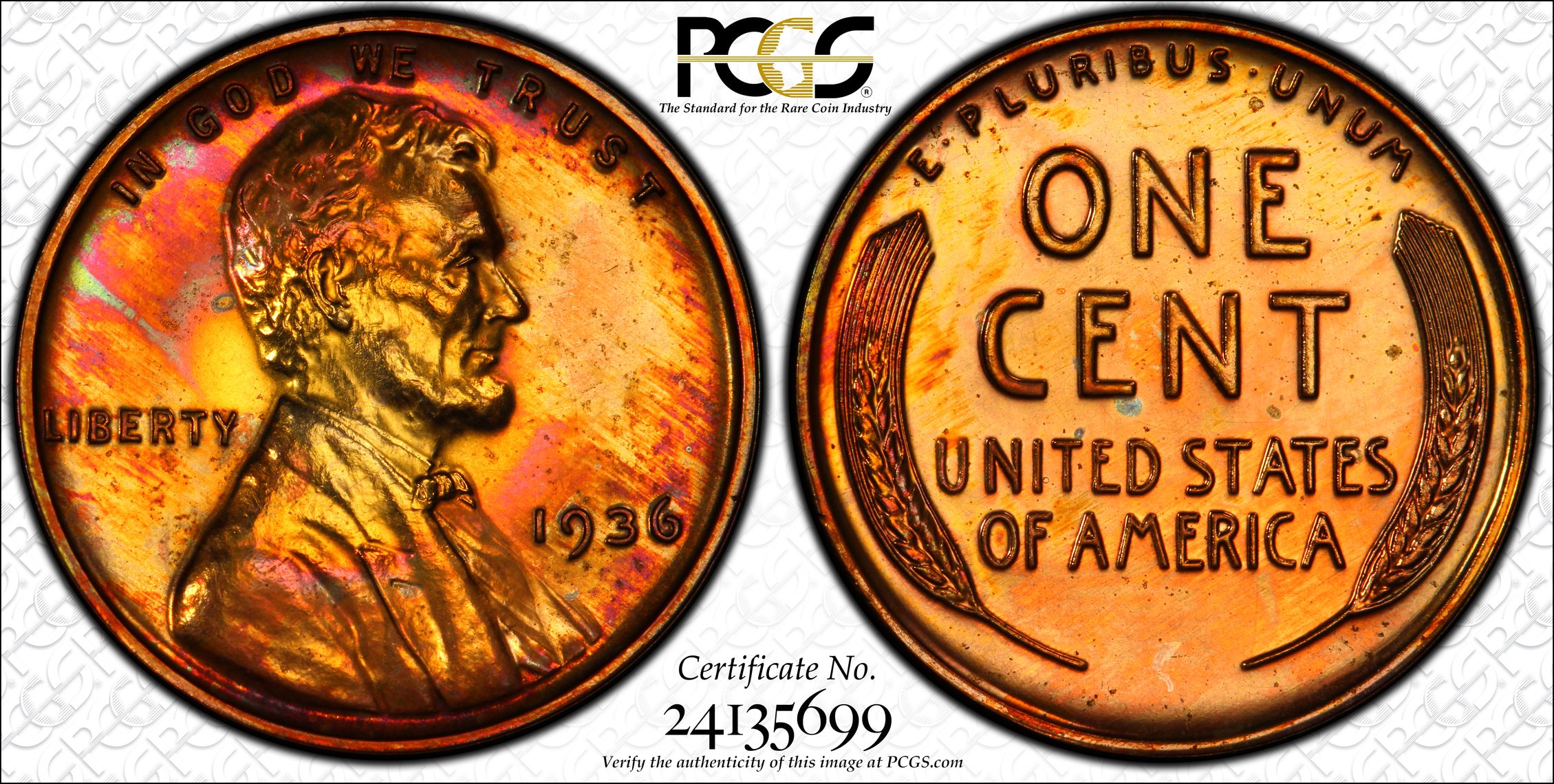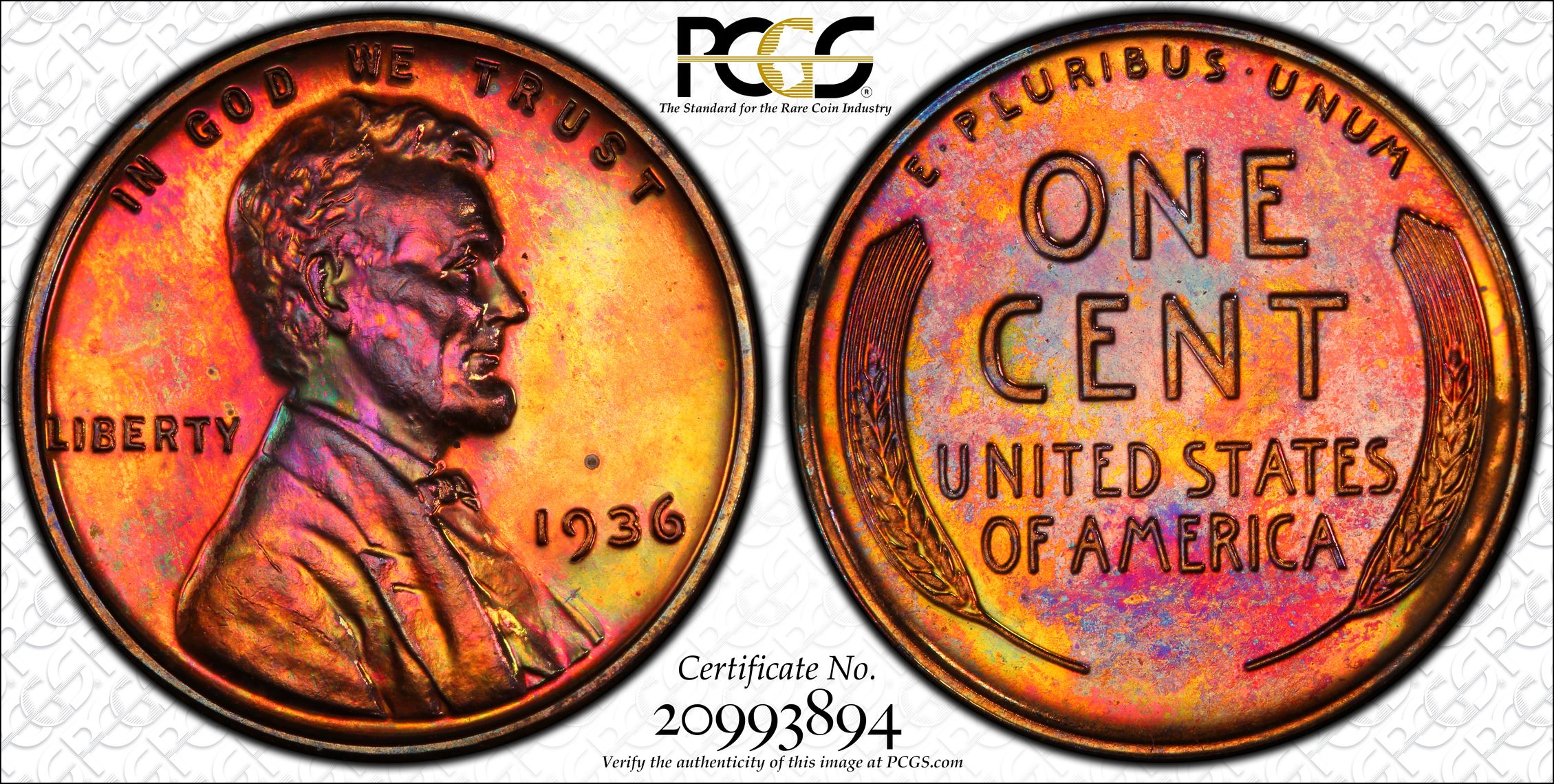A fantasically toned 1936 Proof Lincoln ... and Satin vs. Brilliant differentiation
 WingedLiberty1957
Posts: 2,992 ✭✭✭✭✭
WingedLiberty1957
Posts: 2,992 ✭✭✭✭✭
The following coin is not mine. I think this was recently graded and imaged, does anybody recognize this coin (or know it's history?) ( kudos and pat on the back to whoever owns this!!!)
PCGS said Brilliant ... Looks Satin

Cert Verification page
It's interesting that the photo shown on the PCGS Cert Verificaiton page (linked above) is not a TrueView (since there is no TrueView background). I always thought that to get a (non-fingerprint) photo of a coin on the PCGS cert verification page, that it had to be TrueView photographed. This coin breaks that paradigm, so I wonder if this is a new policy of PCGS to photograph all coins and post pictures on the Cert Verif page, even if no TV photo was ordered.
Also I was wondering, if you all thought this was a Brilliant or a Satin Proof? The PCGS graders called this coin above a Brilliant Proof. I probably would have guessed it was a Satin proof due to the lack of a brilliant mirror.
A second question:
I was wondering if anybody knows the "tells" on differentiating a Brilliant from a Satin proof (for 1936 Lincoln Cents).
I recently had this 1936 graded, and the PCGS graders called this one a Satin Proof. I would have sworn it was a Brilliant Proof (just look at the mirrors!).
There must be something about the Brilliant vs. Satin proof differentiation that I just don't get or understand. If anyone has any input one the best way to differentiate a Brilliant from a Satin proof, please post.
PCGS said Satin ... Looks Brilliant

Here is another somewhat confusing example. This is a stunningly beautiful 1936 proof owned by CU Member Goldbully (kudos to Goldbully for picking this monster up). This was called Brilliant by the PCGS graders. I probably would have called it a Satin Proof (since it doesn't have that shiny reflective mirror-like finish).
PCGS said Brilliant ... Looks Satin

So what "tell" are the PCGS graders looking at to differentiate Satin vs Brilliant? Any ideas? I would love to learn.
PCGS said Brilliant ... Looks Satin

Cert Verification page
It's interesting that the photo shown on the PCGS Cert Verificaiton page (linked above) is not a TrueView (since there is no TrueView background). I always thought that to get a (non-fingerprint) photo of a coin on the PCGS cert verification page, that it had to be TrueView photographed. This coin breaks that paradigm, so I wonder if this is a new policy of PCGS to photograph all coins and post pictures on the Cert Verif page, even if no TV photo was ordered.
Also I was wondering, if you all thought this was a Brilliant or a Satin Proof? The PCGS graders called this coin above a Brilliant Proof. I probably would have guessed it was a Satin proof due to the lack of a brilliant mirror.
A second question:
I was wondering if anybody knows the "tells" on differentiating a Brilliant from a Satin proof (for 1936 Lincoln Cents).
I recently had this 1936 graded, and the PCGS graders called this one a Satin Proof. I would have sworn it was a Brilliant Proof (just look at the mirrors!).
There must be something about the Brilliant vs. Satin proof differentiation that I just don't get or understand. If anyone has any input one the best way to differentiate a Brilliant from a Satin proof, please post.
PCGS said Satin ... Looks Brilliant

Here is another somewhat confusing example. This is a stunningly beautiful 1936 proof owned by CU Member Goldbully (kudos to Goldbully for picking this monster up). This was called Brilliant by the PCGS graders. I probably would have called it a Satin Proof (since it doesn't have that shiny reflective mirror-like finish).
PCGS said Brilliant ... Looks Satin

So what "tell" are the PCGS graders looking at to differentiate Satin vs Brilliant? Any ideas? I would love to learn.
0
Comments
36 satin link
http://macrocoins.com
I wish you would take a photo of the 1950 Lincoln.
I wasn't aware the mint produced anything other than brilliant proofs in 1950.
- Bob -

MPL's - Lincolns of Color
Central Valley Roosevelts
<< <i>Hi Ray
I wish you would take a photo of the 1950 Lincoln.
I wasn't aware the mint produced anything other than brilliant proofs in 1950. >>
i'd love to see this attributed as such
only true oddity i aware of pertains with the 1964 sms series
ngc and pcgs state them to be "sms"
anacs at first have labeled some as 1964 satin...
now pcgs even has changed from sms to sp for 65-67...i'm not sure if that will apply to 1964 too
but yeah
a 1950 satin labelled i'd love to see
<< <i>
<< <i>Hi Ray
I wish you would take a photo of the 1950 Lincoln.
I wasn't aware the mint produced anything other than brilliant proofs in 1950. >>
i'd love to see this attributed as such
only true oddity i aware of pertains with the 1964 sms series
ngc and pcgs state them to be "sms"
anacs at first have labeled some as 1964 satin...
now pcgs even has changed from sms to sp for 65-67...i'm not sure if that will apply to 1964 too
but yeah
a 1950 satin labelled i'd love to see >>
Not an oddity...they're listed in the Red Book as I remember and QDB gives a sentence describing them in his "A Guide Book of Lincoln Cents":
"The earlier Proofs of the year have a hybrid finish that is mirrorlike but with some satiny graininess."
Well, this one is not really mirrorlike at all but does have mirrored edges. It was also my first toned Lincoln and got me into collecting Lincoln toners.
I don't know if PCGS will list these as Satin Proof. Anyone know?
Ray
http://macrocoins.com
"The earlier Proofs of the year have a hybrid finish that is mirrorlike but with some satiny graininess." "
this apply's to 1936
but 1950?
"Earlier proofs of the year (1950) have a hybrid finish that is mirrorlike but with some satiny graininess"
This is listed in the subsection "The Year 1950" on page 210.
PCGS might not attribute, but other numistmatists have noticed this single year oddity.
I am not saying that my 1950 Proof Lincoln is a hybrid-satin ... but it's interesting that it does show at least a little bit of satiny graininess. Perhaps this was an early die state proof.
A Possible 1950 Hybrid-Satin?? (not attributed)
My Coin Blog
My Toned Lincoln Registry Set
truly a treat being schooled here that 1950 in fact was the same as 1936
satins and brilliants exsist
The first image looks like a coinfacts image, they do not use the background for those. PCGS can image any coin they want for use on coinfacts.
<< <i>nicccce 1950 as with those 36's too
truly a treat being schooled here that 1950 in fact was the same as 1936
satins and brilliants exsist >>
Same here!! Thank you Ray and WL. That fact took completely by surprise.
- Bob -

MPL's - Lincolns of Color
Central Valley Roosevelts
if you "search" you should be able to find threads, mainly dedicated to the Half-Dollar.
I bet that 8 year gap in proof production (1942-1950) left a big experience hole in the mint worker's knowledgebase.
It seems plausible that it took them a while to get up to speed again.
My Coin Blog
My Toned Lincoln Registry Set
more detailed die. Look at Lincoln's collar. I can only assume that the dies were prepared
differently and the business proof is not as detailed. Could that be?
Just a guess.
bob
<< <i>I can verify that in the "Guidebook of Lincoln Cents" by David Bowers, he does write
"Earlier proofs of the year (1950) have a hybrid finish that is mirrorlike but with some satiny graininess"
This is listed in the subsection "The Year 1950" on page 210. >>
Thanks for the verification. Being a newbie on the forum (only 6 years and 600-odd posts) and to collecting (just 40 years this year, still a YN!!) I appreciate it when my posts are verified for correctness. But a tip...when you verify someone's post, it's good to get the quote right...
Ray
http://macrocoins.com
well, i'm not seeing that, but suuposing that it appears more detailed could be as simple as the picture/tone or a better struck/higher grade coin which would show more detail. i have always thought that the 1950 era coins which appear as Satin are better described as having a Matte finish more comparable to the SMS issues from the 1990's. those coins more closely mimic a high grade Mint State coin than a Proof coin. to that end, the 1936 Satin coins i've owne have all been unmistakeable Proofs with just a different appearance to the fields.
https://pcgs.com/setregistry/showcase/2819